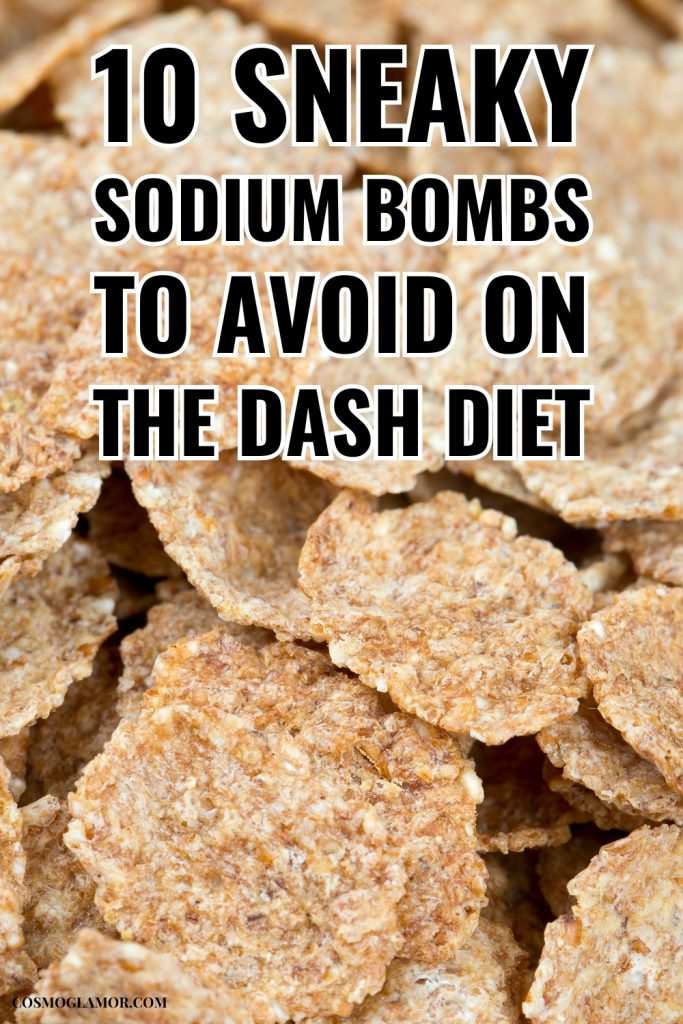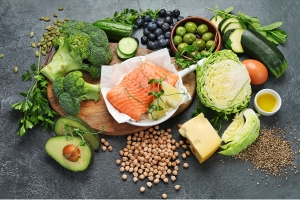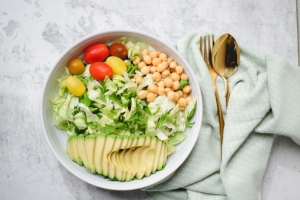Confession time: My initial experience with the DASH diet was… less than perfect. I loaded up on vegetables and lean protein, feeling quite virtuous. Then, my blood pressure check revealed a surprising truth: I was inadvertently consuming far too much sodium.
It’s not just about avoiding the salt shaker (although, that’s a good start!). The real challenge lies in the hidden sodium lurking in unexpected places – a culinary ninja, undermining healthy eating plans.
Why All the Fuss About Sodium? (A Quick DASH Diet 101)

Before we expose the sodium culprits, let’s briefly review the DASH diet. It stands for Dietary Approaches to Stop Hypertension, a heart-healthy eating plan supported by research from the National Institutes of Health (NIH). The core principles involve increasing intake of fruits, vegetables, whole grains, lean protein, and low-fat dairy, while significantly reducing sodium.
The DASH diet typically recommends limiting sodium to under 2,300 mg per day. Individuals with existing high blood pressure may be advised to aim for 1,500 mg. This is a relatively small amount, considering the prevalence of sodium in the modern food supply.
The key takeaway: most of us consume far more sodium than we realize, primarily from processed and packaged foods, not from added salt during cooking. In fact, over 70% of our sodium intake comes from these hidden sources.
Unmasking the Salty Villains: Where Sodium Hides
Sodium serves several important functions in food processing: it acts as a preservative, enhances flavor, and influences texture. While not inherently “evil,” the excessive use of sodium in food manufacturing makes it easy to exceed recommended daily limits.
The problem is that this sodium often hides in foods that don’t taste particularly salty, making it difficult to track. This includes everyday items like bread, sauces, and even breakfast cereal.
The 10 Sneakiest Sodium Bombs (and How to Defuse Them)
Let’s identify the top 10 offenders, along with healthier alternatives that allow you to enjoy your meals without compromising your sodium goals.
1. The Bread Bandit: Commercially Prepared Whole Wheat Bread

- Why it’s sneaky: “Whole wheat” often equates to “healthy” in our minds, and bread doesn’t always taste salty. However, a single slice can contain 100-200 mg of sodium. A sandwich can quickly consume a significant portion of your daily allowance.
- The Swap: Consider baking your own bread (it can be a surprisingly rewarding experience!). Alternatively, look for “low-sodium” commercial bread options, aiming for under 100mg per slice.
2. The Deli Deception: Deli-Sliced Turkey Breast

- Why it’s sneaky: It’s often perceived as a lean and healthy protein source. However, deli meats are frequently loaded with sodium for preservation and flavor, potentially exceeding 400 mg per serving.
- The Swap: Roast your own chicken or turkey breast (without added salt). It’s more cost-effective, provides superior flavor, and allows for complete control over sodium content.
3. Pizza Peril: Cheese Pizza

- Why it’s sneaky: A popular comfort food, pizza’s sodium comes from multiple sources: the crust, cheese, sauce, and any processed meat toppings. A single slice can easily contain 600-1200 mg of sodium.
- The Swap: Embrace homemade pizza night! Use a whole wheat crust (check sodium content on pre-made options), load up on vegetables, use low-sodium cheese sparingly, and make your own sauce (or choose a low-sodium alternative).
4. Soup Sabotage: Canned Chicken Noodle Soup

- Why it’s sneaky: Often viewed as a comforting and easy meal, canned soups can be extremely high in sodium, sometimes reaching over 800mg per cup – nearly half the daily allowance for some individuals.
- The Swap: Prepare your own soup. It’s surprisingly simple, and you can freeze leftovers for convenience. Use low-sodium broth, plenty of vegetables, and lean protein.
5. Cheese Conundrum: Cheddar Cheese

- Why it’s sneaky: While cheese can add flavor to meals, even moderate amounts of cheddar can contribute significantly to sodium intake (around 180mg per ounce).
- The Swap: Explore lower-sodium cheese options like Swiss or fresh mozzarella. Alternatively, use a smaller quantity of a strong-flavored cheese for maximum impact with less sodium.
6. Cereal Betrayal: Bran Flakes

- Why it’s sneaky: Many perceive bran flakes as a healthy, high-fiber breakfast. However, some brands contain a surprisingly high amount of sodium (over 200mg per serving) used as a preservative.
- The Swap: Choose plain oatmeal. It may seem bland initially, but it’s a versatile base for adding fruits, unsalted nuts, and spices for a flavorful and low-sodium breakfast.
7. Dressing Danger: Bottled Salad Dressing (Vinaigrette)

- Why it’s sneaky: Even seemingly healthy dressings like vinaigrettes can contain significant amounts of sodium for flavor and preservation (up to 620 mg per serving).
- The Swap: Create your own dressing. It’s a simple combination of oil, vinegar, and seasonings, allowing for complete control over sodium content. Alternatively, use a squeeze of fresh lemon or lime juice.
8. Ketchup Calamity: Tomato Ketchup

- Why it’s sneaky: A ubiquitous condiment, ketchup’s sodium content (150-190 mg per tablespoon) can quickly accumulate, especially with larger serving sizes.
- The Swap: Seek out low-sodium ketchup options, or make your own tomato sauce without added salt.
9. Canned Veggie Villain: Canned Green Beans (Regular)

- Why it’s sneaky: While vegetables are naturally low in sodium, the canning process often involves adding salt as a preservative, resulting in 230-460 mg per ½ cup serving.
- The Swap: Opt for fresh or frozen green beans, or choose canned green beans specifically labeled “no salt added.”
10. Nutty Nemesis: Salted Nuts

- Why it’s sneaky: Nuts are a healthy snack, but salted varieties can contribute significantly to sodium intake.
- The Swap: Unsalted nuts.
Quick Reference Table:
| Sneaky Sodium Bomb | Typical Sodium (per serving) | Healthy Swap | Approx. Sodium (per serving) |
| Commercial Whole Wheat Bread | 100-200 mg per slice | Homemade/Low-Sodium Bread | 80-160 mg per slice |
| Deli-Sliced Turkey Breast | 400-466 mg per 2 oz | Roasted Chicken/Turkey (No Salt Added) | ~30 mg per 2 oz |
| Cheese Pizza (Plain) | 600-1200 mg per slice | Homemade Veggie Pizza (Low-Sodium) | 132-240 mg per slice |
| Canned Chicken Noodle Soup | 390-890+ mg per 1 cup | Homemade Soup (Low-Sodium) | 50-132 mg per cup |
| Cheddar Cheese | 170-190 mg per ounce | Low-Sodium Swiss/Fresh Mozzarella | 30-138 mg per ounce |
| Bran Flakes Cereal | 220-280 mg per 1 cup | Plain Oatmeal (No Salt Added) | 1-9 mg per cup |
| Bottled Salad Dressing (Vinaigrette) | 200-620 mg per 2 tbsp | Homemade Olive Oil & Vinegar Dressing | 0-132 mg per 2 tbsp |
| Tomato Ketchup | 150-190 mg per tablespoon | Low-Sodium Ketchup/Homemade Tomato Sauce (No Salt Added) | 0-27 mg per tablespoon |
| Canned Green Beans (Regular) | 230-460 mg per ½ cup | Fresh/Frozen/Canned Green Beans (No Salt Added) | 2-20 mg per ½ cup |
| Salted Nuts | ~141mg per ounce (almonds) | Unsalted Nuts | ~0 mg per ounce |
The Bottom Line
Successfully managing sodium intake on the DASH diet requires awareness and proactive choices. It’s about becoming a “sodium detective,” reading labels carefully, and prioritizing whole, unprocessed foods whenever possible. Don’t be afraid to experiment with herbs, spices, and other sodium-free flavor enhancers.
Remember, consistency is key. Even small, incremental changes in your food choices can lead to significant reductions in overall sodium intake and contribute to improved health outcomes.





